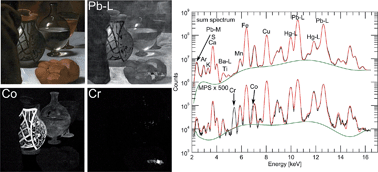Strategies for processing mega-pixel X-ray fluorescence hyperspectral data: a case study on a version of Caravaggio's painting Supper at Emmaus
Abstract
Technical progress in the fields of X-ray sources, optics and detectors is constantly enhancing the pace of data acquisition in XRF imaging. This enlarges the size of the hyperspectral datasets and the number of their sub-parts. This paper describes the challenges in processing large XRF datasets featuring several million pixels/spectra and the strategies developed to overcome them. During the investigation of historical paintings by scanning macro-XRF the main challenges are the correct identification of all spectral features in a dataset and its timely processing. For the identification of spectral features different approaches are discussed, i.e. the use of sum spectra, maximum pixel spectra and of χr2 maps. For the time-efficient, artefact-free evaluation of XRF imaging data, different software packages are evaluated and intercompared (AXIL, PyMCA, GeoPIXE and the in-house written datamuncher). The process of data evaluation is illustrated on a large dataset (3.4 MPixels) acquired during the investigation of a version of Caravaggio's Supper at Emmaus (143 × 199.5 cm2). This 17th century painting is currently the largest object entirely scanned with macroscopic XRF.

- This article is part of the themed collection: Synchrotron radiation and neutrons in art and archaeology

 Please wait while we load your content...
Please wait while we load your content...